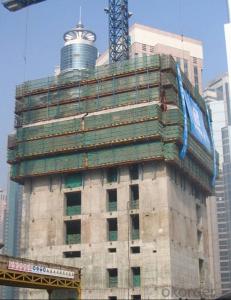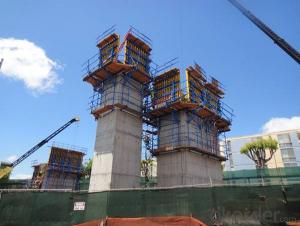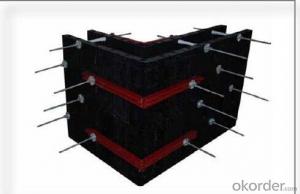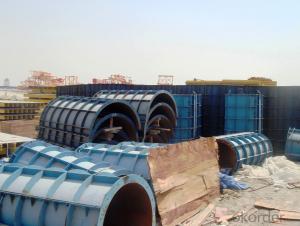Rosette Scaffolding Formwork China Scaffolding Low Price
- Loading Port:
- Tianjin
- Payment Terms:
- TT OR LC
- Min Order Qty:
- 10000 set
- Supply Capability:
- 50000 set/month
OKorder Service Pledge
OKorder Financial Service
You Might Also Like
Rosette Scaffolding Formwork China Scaffolding Low Price
Circular Column Formwork Outrigger For Scaffolding With New Design
Plastic Formwork Concrete Formwork Circular Column Used Scaffolding Props New Design
Developing with new technology materials, steel formworks is no longer a must in construction concrete process. More and more buildings are established with plastic formworks. And workers love this new formworks much more.
The advantages of plastic formworks:
1.First of all--light
Yes it is the first advantage of plastic formwork. It wins the great praise of both contractors and workers.
The biggest panel is 120×1500px,weights 10.5kg only. It can be lift and set up by one person easily, which means there is no need for cranes on site.Saves a lot of cost and time.
2.Easy set up
Different size of panels can firmly locked by simply turn the special handles to 90 degree. The Panels has rib on the back, which makes the system need not traditional wood blocks and nails. The panels have holes to fit tie rod, guarantee the strength of the whole system.
3.Modularity
Modular formworks composed by different size of panels..
4.Strength
The handles are made by high strength Nilon, each panel locked by at least 4 handles, which makes the whole system strong enough to pour 1000px walls.
5.Environment friendly
The system needs no cut and nail due to the variety size. Also it needs nearly no wood. The material can be recycled after broken, so it will not pollute the environment.
6.Consequent
Concrete does not stick to plastic formwork, thus the panels need no oil before using, and can be cleaned simply by water. The surface of the wall which build by modular formwork is smooth and without rework.
Rosette Scaffolding Formwork China Scaffolding Low Price
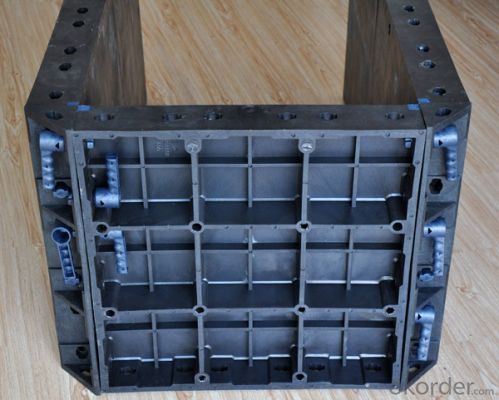
Rosette Scaffolding Formwork China Scaffolding Low Price
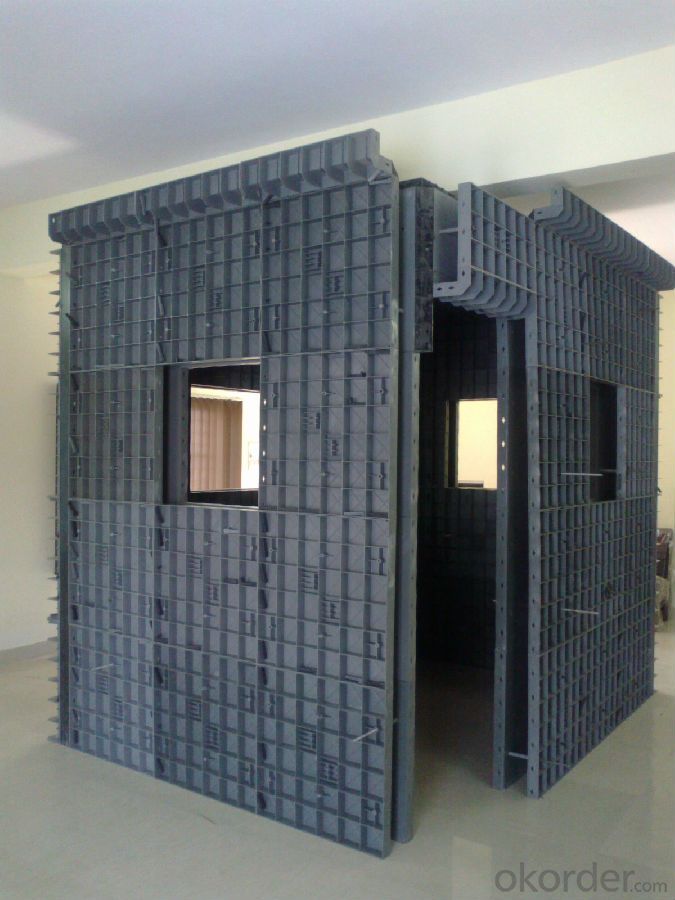
Rosette Scaffolding Formwork China Scaffolding Low Price
Advantage
* Good loading capacity
* Easy to assemble and dismantle
* Stable and durable thanks to its structual design & automatic welding quality
* Customized solution helps you work safe, save cost and convenient
* Excellent quality for formwork & scaffolding with wide choices
Packing
in bulk or in bundle, or as requested
Shipping
15-20 Days.
Normally small orders, it needs just 15-20 business days to the port. For goods with stock, it would be even shoter.
Rosette Scaffolding Formwork China Scaffolding Low Price
Other scaffolding & formwork products:
(1) Scaffolding System:
Including Ringlock Scaffolding System and accessories; Cuplock Scaffolding System and accessories; Kwikstage Scaffolding System and accessories; Haki Scaffolding System and accessories;
(2) Scaffolding Frame & Accessories:
Including Walk Through Frame Scaffolding; Ladder Frame Scaffolding; Accessories; we also can make scaffolding according to your samples or drawings.
(3) Scaffolding Couplers/Clamps:
We can produce all kinds of forged and pressed couplers, including British type couplers, American type couplers, German type couplers, Italian type couplers ,fence couplers, BRC coplers and so on. We also can produce according to your drawings or samples.
FAQ Rosette Scaffolding Formwork China Scaffolding Low Price
Why Us?
We are one of the Top 500 in the world, largest construction materials supplier in China. Also we are a state-owned company and respond to every customer with large and also small orders.
We own professional manufacturers with powerful producing capacity.
Extensive and comprehensive quality control system
Excellent products with competitive prices.
Efficient services in pre and after sale.
Full energy with affluent experience team.
- Q:How does steel frame formwork handle extreme weather conditions?
- Steel frame formwork is designed to be highly durable and resistant to extreme weather conditions. Its sturdy steel construction ensures that it can withstand heavy rain, high winds, and even extreme temperatures without compromising its structural integrity. Additionally, steel frame formwork is often coated with protective finishes or coatings, such as galvanization or epoxy, which further enhance its resistance to corrosion and weathering. This enables it to remain reliable and functional even in harsh weather conditions, making it an ideal choice for construction projects in areas prone to extreme weather.
- Q:Are there any specific considerations for using steel frame formwork in high-temperature environments?
- Yes, there are specific considerations for using steel frame formwork in high-temperature environments. Steel has a high thermal conductivity, which means it can absorb and transfer heat quickly. In high-temperature conditions, steel formwork may expand, potentially leading to warping or deformation. It is crucial to choose steel with a high melting point and thermal stability to avoid structural integrity issues. Additionally, proper insulation and cooling measures should be implemented to prevent excessive heat transfer and minimize the impact of thermal expansion on the formwork system.
- Q:How does steel frame formwork contribute to the overall durability of a concrete structure?
- Steel frame formwork contributes to the overall durability of a concrete structure by providing a strong and rigid framework that ensures proper alignment and support during the pouring and setting of concrete. This formwork system helps in achieving accurate dimensions and preventing any deformation or cracking of the concrete. Additionally, the steel frame formwork is highly resistant to wear and tear, corrosion, and other environmental factors, thus enhancing the longevity and durability of the concrete structure.
- Q:What are the different methods of leveling and adjusting steel frame formwork?
- There are several methods of leveling and adjusting steel frame formwork, depending on the specific requirements of the construction project. Some of the most common methods include: 1. Jacking system: This method involves using hydraulic jacks to adjust the formwork to the desired level. The jacks are placed at strategic points along the frame and can be easily controlled to raise or lower the formwork as needed. 2. Wedges: Wedges are commonly used to level and adjust steel frame formwork. They are placed under the formwork at specific points and can be driven in or removed to achieve the desired level. Wedges offer a simple and effective way to make incremental adjustments. 3. Shims: Shims are thin, tapered pieces of material that are used to level and adjust formwork. They are typically made of metal or plastic and are placed between the formwork and the supporting structure to create a level surface. Shims can be stacked or removed as needed to achieve the desired level. 4. Screw jacks: Screw jacks are similar to hydraulic jacks but operate using a threaded rod mechanism. They can be easily adjusted by turning the rod clockwise or counterclockwise to raise or lower the formwork. Screw jacks are commonly used in conjunction with other leveling methods to fine-tune the formwork. 5. Leveling plates: Leveling plates are flat, steel plates that are used to distribute the load and level the formwork. They are placed under the formwork at strategic points and can be adjusted by adding or removing shims or wedges. Leveling plates provide a stable base for the formwork and ensure even distribution of weight. 6. Laser leveling: Laser leveling is a more advanced method that utilizes laser technology to achieve precise leveling. A laser level is set up at a reference point, and the formwork is adjusted based on the laser beam. This method is highly accurate and efficient, but it requires specialized equipment and expertise. In conclusion, there are various methods of leveling and adjusting steel frame formwork, ranging from simple manual techniques to advanced laser leveling. The choice of method depends on factors such as the project requirements, available resources, and desired level of accuracy.
- Q:Can steel frame formwork be used for both residential and commercial construction?
- Yes, steel frame formwork can be used for both residential and commercial construction. Its strength, durability, and versatility make it suitable for various construction projects, regardless of their scale or purpose.
- Q:How does steel frame formwork handle the placement of external cladding and façade materials within the concrete structure?
- Steel frame formwork is a versatile and efficient system for the construction of concrete structures, including the placement of external cladding and façade materials. This system provides several benefits that make the process easier and more manageable. Firstly, steel frame formwork provides a strong and stable framework for the placement of external cladding and façade materials. The steel frames are designed to withstand the pressure exerted by the concrete during pouring and ensure the structural integrity of the final product. This stability allows for the secure attachment of cladding and façade materials, ensuring they are properly aligned and fixed in place. Furthermore, the steel frames can be easily adjusted and customized to accommodate different types and sizes of cladding and façade materials. This flexibility allows for the precise placement of materials and ensures a seamless and aesthetically pleasing finish. Additionally, the steel frames can be easily dismantled and reassembled, allowing for easy access to the structure for maintenance or repairs in the future. Another advantage of steel frame formwork is its ability to provide a smooth and even surface for the placement of cladding and façade materials. The formwork system is designed to minimize any imperfections or irregularities in the concrete surface, ensuring a consistent and level base for the installation of materials. This results in a high-quality finish and enhances the overall appearance of the structure. Additionally, steel frame formwork allows for the integration of various construction techniques and materials, such as precast panels or curtain walls. This versatility enables the incorporation of different architectural design elements and aesthetics into the concrete structure. The steel frames can be easily adapted to accommodate the specific requirements of the cladding and façade materials, allowing for a seamless integration with the overall design concept. In conclusion, steel frame formwork provides a reliable and efficient solution for handling the placement of external cladding and façade materials within a concrete structure. Its strength, stability, flexibility, and ability to provide a smooth surface make it an ideal choice for ensuring the proper installation and integration of these materials, resulting in a high-quality and visually appealing finished product.
- Q:Are there any limitations or disadvantages to using steel frame formwork?
- Yes, there are limitations and disadvantages to using steel frame formwork. One limitation is the high initial cost of steel formwork compared to other materials. Additionally, steel formwork can be heavy and difficult to transport, making it less suitable for remote or difficult-to-access construction sites. Another disadvantage is that steel formwork requires skilled labor for installation and removal, which may increase labor costs. Furthermore, steel formwork is prone to corrosion, requiring regular maintenance and protective coatings to ensure its durability. Lastly, steel formwork is less flexible and adaptable compared to other formwork systems, limiting its versatility in complex architectural designs.
- Q:What are the different types of steel used in steel frame formwork systems?
- There are several different types of steel used in steel frame formwork systems, including mild steel, high tensile steel, and alloy steel. Mild steel is the most commonly used type and is known for its affordability and versatility. High tensile steel is stronger and more durable, making it suitable for heavy-duty applications. Alloy steel is a combination of different metals, offering enhanced strength and resistance to corrosion. The specific type of steel used depends on the requirements of the formwork system and the desired properties of the structure being built.
- Q:What are the different types of joints used in steel frame formwork?
- There are several types of joints used in steel frame formwork, each serving a specific purpose in the construction process. 1. Butt Joint: This is the most common type of joint used in steel frame formwork. It involves joining two steel members end to end, creating a flush and seamless connection. Butt joints are typically used in straight sections of the formwork where no angular changes are required. 2. Lap Joint: A lap joint is used when two steel members need to be connected side by side. One member overlaps the other, and the two are then welded or bolted together. This type of joint is commonly used in situations where additional strength and stability are needed, such as in corners or areas with high load-bearing requirements. 3. Corner Joint: As the name suggests, corner joints are used to connect steel members at corners or angles. These joints are designed to ensure a strong and stable connection, allowing the formwork to maintain its shape and withstand the forces exerted during the concrete pouring process. 4. T-Joint: T-joints are used to connect three steel members in a T-shape configuration. This type of joint is commonly used in situations where additional support or reinforcement is needed at specific points of the formwork system. 5. Splice Joint: Splice joints are used to connect two steel members end to end, similar to a butt joint. However, unlike butt joints, splice joints are typically used to connect longer sections of the formwork where a seamless connection is not necessary. Splice joints are often used in situations where ease of assembly and disassembly is important. Overall, the choice of joint used in steel frame formwork depends on the specific requirements of the construction project. Each type of joint offers its own advantages in terms of strength, stability, and ease of assembly, allowing the formwork system to be customized to meet the needs of the project.
- Q:What are the different types of corner profiles used with steel frame formwork?
- Steel frame formwork systems commonly utilize various types of corner profiles to enhance stability and support. These profiles maintain the formwork's position and enable it to withstand the concrete's pressure. One frequently utilized corner profile is the L-shaped variant, which is typically composed of steel and possesses a 90-degree angle. Its purpose is to reinforce and support the formwork at its corners. By evenly distributing the load, the L-shaped corner profile prevents weak points or bending. Similarly, the T-shaped corner profile, also made of steel, is another option. Its design provides additional strength and stability to the formwork's corners. This profile effectively prevents any potential movement or shifting during the concrete pouring process, ensuring secure placement. Moreover, adjustable corner profiles are available for steel frame formwork systems. These profiles can be modified to different angles, allowing for flexibility in formwork design. They prove particularly beneficial in handling irregular shapes or creating angled corners. To sum up, steel frame formwork systems employ L-shaped corner profiles, T-shaped corner profiles, and adjustable corner profiles. These profiles play a crucial role in ensuring stability, reinforcement, and support for the formwork system, guaranteeing its durability and effectiveness during the concrete pouring process.
1. Manufacturer Overview |
|
|---|---|
| Location | |
| Year Established | |
| Annual Output Value | |
| Main Markets | |
| Company Certifications | |
2. Manufacturer Certificates |
|
|---|---|
| a) Certification Name | |
| Range | |
| Reference | |
| Validity Period | |
3. Manufacturer Capability |
|
|---|---|
| a)Trade Capacity | |
| Nearest Port | |
| Export Percentage | |
| No.of Employees in Trade Department | |
| Language Spoken: | |
| b)Factory Information | |
| Factory Size: | |
| No. of Production Lines | |
| Contract Manufacturing | |
| Product Price Range | |
Send your message to us
Rosette Scaffolding Formwork China Scaffolding Low Price
- Loading Port:
- Tianjin
- Payment Terms:
- TT OR LC
- Min Order Qty:
- 10000 set
- Supply Capability:
- 50000 set/month
OKorder Service Pledge
OKorder Financial Service
Similar products
New products
Hot products
Hot Searches
Related keywords
